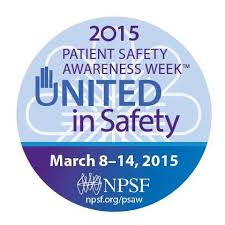This week’s annual Patient Safety Awareness Week highlights one of the most important parts of a nurse’s job. Every nurse knows that keeping healthcare providers and patients safe is essential. Sometimes, however, it take a fresh approach to make the issue fresh and foremost.
The National Patient Safety Foundation highlights the issue one week annually, but nurses know they can never let their guards down when it comes to patient safety. In a career where the days are frequently chaotic and unpredictable, having standards and safe practices in place protects everyone. This year’s theme “United in Safety” considers all members of the patient’s team – the patient, the nurses and physicians who care for the patient, and even the support team of family and friends.
If everyone is one the same page and the patient is able to understand a condition and the expected treatment (or has a loved one who can), the outcome is better all around.
In honor of Patient Safety Awareness Week, how can you find some new ways for your team to look at the issue? Talk about patient safety this week and encourage staff and patients to do the same.
What are some topics to bring up? Discuss the importance of open communication between healthcare providers and the patients and their families and give examples of what that means. For example, bring up the importance of honesty. That means both sides will be honest about everything from treatment plans to medication compliance to safety standards.
Talking with patients and their families should include open discussion about letting you know how they feel, if any part of their health has changed,
and especially if they don’t understand parts of the care plan, how to maintain it, or where to go for help if they are having difficulty.
And the NPSF has plenty of tools online to help keep patients and healthcare providers on the same page. Encourage patients to download the Medication White Board or the How to Read Your Pathology Report information sheet. Patients and their families can also fill out a Personal Medical Journal that lists all the personal contact and medical information in one neat packet. Let patients know why this is an essential part of their healthcare plan and how having such clear and accessible information available can prevent medication and treatment errors. After all, if they are on a medication and they forget to mention it in a time of crisis, the healthcare team is going to lack some crucial information. When patients and their care teams can link this kind of cause and effect together, they might be more inclined to see the importance of open communication and exactly what it means.
In the workplace, there are plenty of ways to honor the week and get people to start talking about patient safety.
Ask staff members to wear purple in honor of Patient Safety Awareness Week and then gather them all together for photos. Post pictures using the #PSAW2015 hash tag (you can also include @theNPSF).
With an effort underway to recognize the week nationally, encourage your local legislators to consider the action by writing a short email or by picking up the phone and calling them.
On Thursday, March 12, at 1 pm ET, you can participate in a free webcast “Patients and Families as Partners: United in Safety.” On Wednesday, March 11, an open Twitter chat on patient and family engagement starts at 8:30 pm ET. If you want to join the conversation, use #PSAWunited.
If you use a mix of these approaches, patient safety, always a top and pressing issue, can take on a new life in your organization.
- WOC Nurses Week Highlights Specialty - April 16, 2024
- Honoring Radiology Nurses Day on April 12 - April 12, 2024
- Travel Offers New Career Possibilities - April 8, 2024



